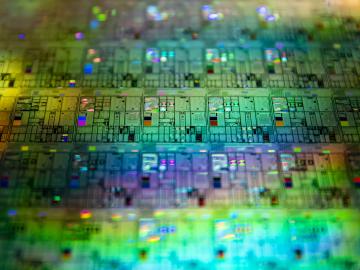
Filter News
Area of Research
- (-) Biological Systems (2)
- (-) Biology and Environment (86)
- (-) Supercomputing (63)
- Advanced Manufacturing (3)
- Biology and Soft Matter (1)
- Computational Engineering (1)
- Computer Science (5)
- Electricity and Smart Grid (3)
- Energy Science (96)
- Functional Materials for Energy (1)
- Fusion and Fission (10)
- Fusion Energy (7)
- Isotope Development and Production (1)
- Isotopes (5)
- Materials (63)
- Materials for Computing (5)
- Mathematics (1)
- National Security (22)
- Neutron Science (27)
- Nuclear Science and Technology (19)
- Nuclear Systems Modeling, Simulation and Validation (1)
- Quantum information Science (9)
- Sensors and Controls (2)
News Topics
- (-) Advanced Reactors (2)
- (-) Bioenergy (52)
- (-) Grid (7)
- (-) Physics (9)
- (-) Quantum Science (25)
- (-) Security (6)
- (-) Space Exploration (3)
- 3-D Printing/Advanced Manufacturing (13)
- Artificial Intelligence (41)
- Big Data (29)
- Biology (76)
- Biomedical (29)
- Biotechnology (15)
- Buildings (6)
- Chemical Sciences (15)
- Clean Water (11)
- Composites (5)
- Computer Science (105)
- Coronavirus (22)
- Critical Materials (4)
- Cybersecurity (9)
- Energy Storage (11)
- Environment (105)
- Exascale Computing (28)
- Frontier (32)
- Fusion (2)
- High-Performance Computing (56)
- Hydropower (8)
- Isotopes (3)
- Machine Learning (20)
- Materials (24)
- Materials Science (22)
- Mathematics (5)
- Mercury (7)
- Microscopy (16)
- Molten Salt (1)
- Nanotechnology (16)
- National Security (9)
- Neutron Science (16)
- Nuclear Energy (5)
- Partnerships (6)
- Polymers (4)
- Quantum Computing (20)
- Simulation (26)
- Software (1)
- Summit (47)
- Transportation (8)
Media Contacts

For the second year in a row, a team from the Department of Energy’s Oak Ridge and Los Alamos national laboratories led a demonstration hosted by EPB, a community-based utility and telecommunications company serving Chattanooga, Tennessee.

In the early 2000s, high-performance computing experts repurposed GPUs — common video game console components used to speed up image rendering and other time-consuming tasks

We have a data problem. Humanity is now generating more data than it can handle; more sensors, smartphones, and devices of all types are coming online every day and contributing to the ever-growing global dataset.

A team from the ORNL has conducted a series of experiments to gain a better understanding of quantum mechanics and pursue advances in quantum networking and quantum computing, which could lead to practical applications in cybersecurity and other areas.

Scientists at have experimentally demonstrated a novel cryogenic, or low temperature, memory cell circuit design based on coupled arrays of Josephson junctions, a technology that may be faster and more energy efficient than existing memory devices.

Researchers at the Department of Energy’s Oak Ridge National Laboratory have received five 2019 R&D 100 Awards, increasing the lab’s total to 221 since the award’s inception in 1963.

A joint research team from Google Inc., NASA Ames Research Center, and the Department of Energy’s Oak Ridge National Laboratory has demonstrated that a quantum computer can outperform a classical computer

The type of vehicle that will carry people to the Red Planet is shaping up to be “like a two-story house you’re trying to land on another planet.

Using the Titan supercomputer at Oak Ridge National Laboratory, a team of astrophysicists created a set of galactic wind simulations of the highest resolution ever performed. The simulations will allow researchers to gather and interpret more accurate, detailed data that elucidates how galactic winds affect the formation and evolution of galaxies.
A team of scientists led by Oak Ridge National Laboratory have discovered the specific gene that controls an important symbiotic relationship between plants and soil fungi, and successfully facilitated the symbiosis in a plant that


